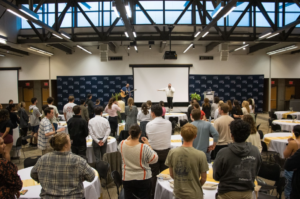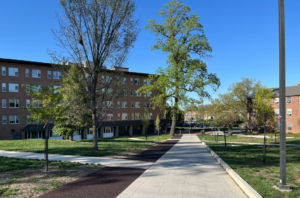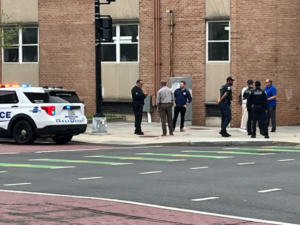Sustainability on Catholic U’s Campus
By Theresa Whitfield
Being recognized as one of the greenest campuses in Washington, D.C. is a point of pride for Catholic University. This recognition came after the university began making efforts towards sustainability.
In 2012, the university joined the District of Columbia Mayor’s College and University Sustainability Pledge along with nine other institutions of higher education. This initiative began under former mayor, Vince Gray, who had a vision for D.C. to become the “healthiest, greenest, and most livable city in the United States,” according to an article published by the U.S. Green Building Council (USGBC).
During the past fall semester, the Office of Facilities Operations hosted sustainability walking tours open to anyone who wished to attend to showcase the university’s efforts on this front. This office is responsible for overseeing the university’s efforts towards environmental health and safety, as well as its energy and environmental systems. The tours highlighted the existing initiatives incorporated into the buildings, transportation, food services, academic research, and even the vegetation on campus.
Catholic University has some of the largest solar installations in the D.C. metropolitan area with 2,600 solar panels generating approximately 830 megawatt hours of clean electricity per year. In the O’Boyle parking lot alone lie 714 panels and in the O’Boyle parking lot there are two electric car chargers.
Possibly without even realizing it, most of the sophomore class is living in a residence hall with many sustainable options implemented. The newest dorm building on campus, Opus Hall, became certified as a Leadership in Energy and Environmental Design (LEED) building in 2010. LEED is “the most widely used green building rating system in the world,” according to the USGBC. Overall, Opus Hall is 10 percent more energy-efficient than average residence halls across the country. Specifically, the building’s water fixtures are 20 percent more efficient than standard indoor plumbing fixtures. Energy-efficient heating and cooling systems and Energy Star certified appliances are installed in the building for students’ everyday use.
Besides the sustainability efforts in the residence hall, some of the academic buildings, specifically Aquinas Hall, Father O’Connell Hall, and the Nursing-Biology building have been structured with the environment in mind. While students inside these buildings are working hard, the building itself is too. Each of these buildings has green roofs, meaning they are partially covered with vegetation. The vegetation on the roofs absorb rainwater and provide insulation.
Students and faculty rely on many different types of transportation to get them to and from the city, and the university has done much to accommodate this need. In the Edward J. Pryzbyla Center is a transit screen that displays real-time transportation feed from a variety of transit modes. The university also offers alternative transportation options such as shuttle rides running during the week. In addition to this, there are 414 bike racks on campus available for all to use. The installation of the bike rack led to Catholic University being recognized by the League of American Bicyclists as one of 48 campuses that are “Bike Friendly.”
Beyond buildings and transportation, there are even sustainable food sources on campus. Dining Services provides food options from many local farmers, growers, and distributors. In 2009, they became trayless which helped to minimize waste, conserve energy and water, and to reduce the number of cleaning chemicals entering the waste stream.
Students also participate in academic research to further the university’s sustainability efforts. The LEED Lab was introduced in 2011 by the School of Architecture and Planning in conjunction with the USGBC and the Green Building Certification Institute. This was a pilot laboratory established with the goal to directly apply its sustainability research into practical efforts on campus. After all the work the lab accomplished, the School of Architecture became the first design school in the world to be LEED certified in 2014.
Through these initiatives, students on Catholic University’s campus are positively contributing to a greener future in the Washington, D.C. community.








